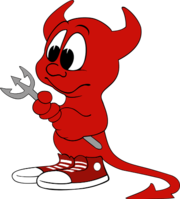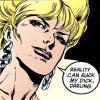Leaderboard
Popular Content
Showing content with the highest reputation on 04/11/2017 in all areas
-

Writing Summaries
Anesor and one other reacted to GeorgeGlass for a topic
I suppose a corollary of what y’all have been saying about hooking the target audience is that different types of stories call for different types of summaries. The summary for a funny story ought to be at least a little bit funny itself, whereas the summary for a mystery ought to be mysterious.2 points -
Hi, stranger :) Sounds so logical now, but never thought of it that way. Admittedly, I'm strange when it comes to books; I usually read the flyleaf after I've skimmed over the first chapter(s) (from which I make a judgement call...), so the summaries, in my case, are more an afterthought. Which is probably reflected in how my writing is… You... Hate... Writing... Summaries? <holds fingers in shape of cross...> Blasphemy! I agree. The two important/interesting elements work and would certainly blend in with what BW said. The set target audience would, consequently, be determined by those; for example, a SciFi romance would likely have the romantic elements outright listed, allowing the intended audience to know. Not only that, but, because of the main themes and elements being presented, you have, hopefully, a hook in the summary that draw people in (...which is exactly what a summary should do and what BW said already...). Obviously, something called Attack of the Killer Lizard Blob People From Planet 672 is not likely to have "Killer Lizard Blob People attack! Bob milks his cows. Joan walks the dog. It's an interesting day." (Although, I'm kind of interested, in a strange way, at why Bob and Joan are doing mundane things as Lizard people are attacking...)2 points
-

Babble Chat
Rescue25 reacted to DemonGoddess for a topic
Hey all, look at the top menu and tabs. You’ll notice that the far right is titled “Babble”. This is the new chat! Registration not required to use it!1 point -
Writing Descriptions When we walk through the world, we’re surrounded by a huge range of things, but we usually don’t notice everything in intimate detail. And that’s because much of what we’re surrounded by just isn’t that important to what we’re currently doing; it’s little more than visual background noise. So when your character walks into a room, just how much of what’s in that room should you describe? In every situation, there are things that need to be described, things that shouldn’t be described, and things that don’t really matter whether you describe them or not. Some people might even cut it down to the first two I just mentioned, and suggest that you never describe anything that isn’t relevant to the story. I disagree with that. While it’s never a good idea to go waffling on describing a whole laundry list of irrelevant crap, mentioning things that might enrich the story in some way is never a bad idea. If it doesn’t enrich the story or a character in any way, though, then leave it out. So what should you describe? You need to provide enough detail to allow the reader to create a visual in their mind that follows your guidelines but is still distinctly their own. People have their own imagination, and we all visualise things differently. By trying to describe every tiny, insignificant detail, you’re attempting to ride rough-shod over their imaginations and force your own into their heads, which can annoy enough to pull them out of the story. By giving your readers the necessary descriptive tools, you allow them to visualise the scene and fill in the blanks, rather than trying to do it all for them. Some writers just love to use extremely flowery language peppered with obsolete words, because they presumably think this makes their descriptions better. Personally, I find this unnecessary at best, annoying and frustrating at worst. You shouldn’t need a dictionary when reading a story. A thesaurus is handy, but make sure your new favourite word hadn’t already fallen out of fashion when Queen Victoria was still a girl. Describing rooms Here’s an example of BAD description and BETTER description. BAD: Stephen turned the door nob and gently pushed the mahogany door, which eased open without a sound. It was a smallish room, perhaps about the size of an average bedroom, or maybe a bit larger. The only light came from a shiny silver candelabra which sat on the mantel over the unlit fireplace. The three candles cast dancing shadows around the room, but there was enough light for him to make out the details. A well-worn three-seater leather couch sat in front of a low, rectangular coffee table. Strewn on the coffee table was a magazine called Country Life, an empty glass, car keys in a small silver dish and a circular metal ashtray filled to the brim with ash and cigarette buts. A wing-backed leather single seater sat near the couch, perched at an oblique angle. The walls were lined with sideboards and glass-fronted cabinets, all stuffed with glass and porcelain ornaments and knick-knacks of all shapes and sizes. What little of the walls he could see were adorned with old-fashioned wallpaper, with stylised patterns of flowers alternating in vertical rows. As Stephen stepped into the room, he felt the thick, shag-pile carpet under his feet. It was hard to tell the exact colour in the dim light, but he thought it was probably a dark red. Taking a seat on the three-seater, Stephen’s first impression was that it wasn’t quite as comfy as he thought it would be; he could feel one or two springs pressing against him. It was only now that he noticed the gentle ticking sound, and saw the mantel clock sitting at the other end of the mantle. BETTER: Stephen eased open the mahogany door without a sound and stepped inside, feeling the plush carpet under his feet. A fireplace sat cold and empty, but a lit candelabra on the mantle cast dancing shadows around the room. The warm glow revealed a busy room bordering on cluttered, but it was the leather lounge in the middle that he made his way to. Leaning back in the slightly uncomfortable chair, Stephen’s gaze fell on the coffee table, showing a small assortment of objects including a glass half full of some dark liquid, but it was the ashtray that caught his attention the most. Ash and cigarette butts filled it to overflowing, with a dusting of ash surrounding it. The ‘better’ description is certainly shorter, but that doesn’t make it worse. Does it really matter exactly how big the room is, that there’s three candles in the candelabra, the other single seater chair, the exact shape of the coffee table, the name of the magazine, the car keys in the dish, the ornaments, the wallpaper, the colour of the carpet, or the clock? I mentioned the ashtray because, in my mind, that has some relevance to the story. Also, describing the half-full glass suggests to the reader that there’s likely to be someone else in the house. If there’s nailhead trim on the leather couch, then mention that, but only if someone is going to snag their clothing on it later, or they subsequently find one of the nailheads elsewhere in the house. Perhaps there’s two empty glasses and a bottle of wine on the coffee table. Or maybe the ornaments are important. But for me, none of that other stuff was significant enough to warrant mentioning. One way you could end up describing more of that room is by having the owner enter the room, strike up a conversation with Stephen and begin talking about some of his ornaments. You’ve already described the fact that the room is cluttered, so the fact that there’s ornaments in the room won’t come as a surprise. On the other hand, if the owner starts talking about the dog in the room then the reader is going to think, ‘Hang on, what dog?’. Adding detail a bit at a time is better than doing it all in one big block of text. When you’re describing an interior, the most important thing is to convey the feel of the room. Is it sparsely furnished or cluttered? Brightly lit or dark and forbidding? Give them enough detail to provide the overall feeling you want, and leave them to furnish the rest of the room in their own minds. Remember, though, if there’s some object in that room that will have significance later in the story then you need to discuss it. The longer you hover over that object, though, the more you tip off the reader that this object is very important. Describing external scenes Describing external scenes can be a lot easier, at least as far as describing landscapes is concerned. Is it a forest dense enough to make it difficult to walk through, or an open forest? Open flat grass plains or rolling hills? You don’t need to – nor should you – attempt to describe every rock and tree. If the weather is cold or hot then you should describe the effect it’s having on the characters. Describe the ice and snow, and how he’s still shivering in spite of his warm clothes. Or how his sweat trickles down his face, and how the sun beats down on him like hammer blows. You shouldn’t need to specifically tell your reader what season it is; that’s what good description is for. If you’re not an architect then describing buildings facades can be difficult, but who wants to read that level of intimate detail? If the style is important – Gothic or Art Deco perhaps – then describe it, but remember that you’re not writing a story on architecture. Describing the condition of the building is important if it’s run-down. Talk about the peeling paint, the cracked and broken windows, the holes in the walls, the kicked in front door; that’s if it’s an abandoned building. If the place is simply run-down rather than abandoned then you’ll probably want to dial that back a bit, unless you wont people to be surprised to find someone still living in it. Describing clothing It’s usually not important what exact clothes your characters are wearing. While you’re spending a full page describing in intimate detail what Samantha is wearing, your reader is working overtime putting all this together and visualising what you’re forcing down their throat. If an item of clothing that she’s wearing will later become significant then discuss that, but only in as much detail as strictly necessary. For example, let’s say Samantha goes jogging. You could mention that she’s wearing her usual tracksuit or active wear, etc, including her old and battered, but comfy, sneakers. You mention the sneakers because later, after she’s been reported missing, these sneakers are found. A detective talking to Samantha’s best friend describes how these shoes are her favourites and was dreading the day she would need to buy new ones, so there’s no way she would simply throw them away. So you could have initially had Samantha having an internal monologue about how these are her favourite shoes, etc, but that’s usually silly and unnecessary, especially when you could have her best friend later relate this information to someone. If the character wears very weird clothing, then describe it; if they’re wearing an ugly tie, then describe it; if there’s something significant about their clothes, then describe it. If you want to convey the idea that it’s hot or cold outside, then describe it. Otherwise, don’t. Describing emotions There’s an old writer’s maxim: Show, don’t tell. You should never have a reason to say “Jeff was angry”. It should be obvious that Jeff was angry from your description. Facial expressions and body language are invaluable in showing what a person is feeling, regardless of what they’re actually saying. Does your character have a nervous tic? Do they blush even more than normal when they’re embarrassed? Or maybe they stammer a bit, or get angry? Do they always scratch an imaginary itch when they’re lying? It should also be obvious that a person is in love with someone, without you needing to type the word ‘love’. Descriptions are vital, but they can also bore readers with great speed. Try and break up your descriptions over various scenes. Bite-sized pieces of descriptions are more palatable than big blocks of them every other paragraph.1 point
-
Creating Characters Have you ever heard of the term, “Mary-Sue”, in relation to stories? If you don’t know what that is then I’ll explain. A “Mary-Sue” story is where the hero of the story is basically you. But not exactly like you, though; a better looking, stronger, braver, more popular, richer you, with super powers! These type of stories are usually pretty obvious, and often draw a lot of flack from people. Mary-Sue’s are not popular, other than with the person that wrote it. But I’m going to go against popular opinion somewhat and say that Mary-Sue’s aren’t all bad. If you’re starting out in the big scary world of story writing then a Mary-Sue type story is almost certainly one of the first types you’re going to write. And that’s okay, it truly is! You’re still learning, and the only way to learn is to write, make mistakes, learn from them, keep writing, make mistakes, etc. So go on, write those Mary-Sue’s, but perhaps you should just keep them to yourself, or maybe only show them to select friends. But you really should be striving towards writing non Mary-Sue stories as soon as you can. But don’t let anybody tell you that published author’s never base characters on themselves, because they very much do. They always have, and they continue to do so. Most successful authors have written novels containing characters that are them to varying degrees. The lead characters in some of the most successful novels have been a carbon copy of the author. But that’s the whole point: the character is just like the author, and nobody is perfect. Every single human being has flaws. And it’s their flaws that makes a character interesting, not their perfections. When people write Mary-Sue’s, what they’re really wanting to see is them as the kind of person they wished they were, so they make them gloriously perfect. Because don’t most of us wish we were perfect? I know I do. But that makes for boring reading for everyone other than the person who wrote it. People can’t relate to perfect characters, because we’re not perfect. People can relate to flawed characters, though, because we ourselves are flawed. But that’s why we like to see the flawed hero triumph, because we can put ourselves in their shoes, and we cheer them on, wanting them to succeed against the odds! You can go overboard with the flaws, though. Unless you really want your character to be thoroughly broken then don’t forget to give them some positives. A character that is so utterly damaged can be difficult for most people to warm to, which is a potential problem if this person is going to be the hero of your story. Those kind of characters can work, though, but usually only if they find some kind of redemption at or near the climax of the story. Still, if they’re thoroughly unlikeable then the journey to that point can be a tough one for your readers. But what about your hero’s friends? What are they like? The temptation for some is to follow what we see in movies and TV series: one friend is black, one friend is gay and one friend is Asian. This sort of political correctness has no part in stories! Take a look at your own circle of friends? Is that really what they look like? Do you actually know anybody who genuinely has a circle of friends like that? Don’t get me wrong, if your character is white then I’m not saying they can’t have any black friends, gay friends or Asian friends. Sure they can! But unless a person lives in a highly multicultural and diverse neighbourhood then it’s extremely unlikely that a person will have that exact make-up of friends. Another temptation is to follow a different type of movie or TV series, which is where each friend is wildly different than the other friends. Opposites attract only in bad fiction. In reality, opposites tend to get on each other’s tits after a while. Again, think about your own friends. Do you have friends who are all totally different from each other, as in nobody has anything in common? I highly doubt it. Maybe you might have one weird friend who is quite different from you, but there’ll still be at least some things about this person that you like, otherwise they wouldn’t be a friend, now would they. Make the friends realistic, not politically correct. What about the villain of your story? Unless you’re writing a super hero or anime-based story, then your bad guy shouldn’t be a cartoon-style super villain, not if you want them to be believable. Just as you want the hero of your story to be someone the reader can warm to, the villain should have the opposite effect on the reader. You really don’t want people to be cheering on the bad guy, unless that really is the type of story you’re going for. Exactly how bad the person is really depends on what type of story and character you’re writing. Is the bad guy you’re garden variety bully and thug, or is he a psychopathic murderer? If he’s just a thug then you don’t want to go overboard and inadvertently turn him into a small town super villain. While you don’t want your audience cheering on the bad guy, you do want the readers to find them believable. If they’re too unbelievable then the reader can start to loose connection with your story. Creating realistic, believable, relatable characters shouldn’t be so difficult. All you really need to do is to take a look at yourself and your friends. If you’re having a hard time warming to your character then so will everybody else.1 point
-

Creating characters
Cuzosu reacted to Desiderius Price for a topic
Good reading. After I decide I’ll need a character, I typically use a random picker to give me a list of traits/hobbies/allergies/phobias, and I’ll see if any work for what I want out of the character. If it’s a marginal character, I’ll pick more freely. If there’s a specific/important reason for the character, I’ll be more selective and reselect until I get something closer. And, after I select, I will record them (I’ve got dossier files for each character) – this is perhaps the most critical, because if I work with the character later, I can keep him/her consistent. At the threat of a mild spoiler, this process helped me this week, because a character needed to eat a lot of a particular food. As I was editing his dossier to make it his favourite, I noticed that I had previously made him allergic to it. This suddenly made the character richer in his personality for deliberately eating something he’s allergic to (and suffering the consequences of it later), and strengthened the plot a bit since I no longer had to make it ill-prepared food. So, for me, my process helps me, helps me have a diversity of characters with different traits, and it helps me when writing because it can fill in those awkward moments, like, when one character gives a gift to somebody else, where the friendship is deep, then what’s the gift? My day job involves software so I have to be very rational, logical, and considering subtle nuances; this is something I carry over into my writing. So, maybe somebody else will find my process useful.1 point -

The Art of Foreshadowing
Wilde_Guess reacted to Melrick for a topic
The Art of Foreshadowing What is it? Quite simply, foreshadowing is to hint at something, in a casual way, where it will be brought up again later on in the story in a more significant and relevant way. The ‘art’ is in exactly how you lay that little hint, without telegraphing “THIS IS IMPORTANT! REMEMBER IT!”. Why it’s important Story telling is easy. No, really, it is! The art is in how you tell the story, that’s what makes it scary, exciting, sexy, etc. Foreshadowing is a very important tool to use in many, if not most, stories. I’m sure most of us have watched movies where all of a sudden, the hero just happens to find the one thing he or she needs to save the day. “Oh that was convenient!” we shout at the screen. It’s far too convenient, and therefore, annoying, for the hero of your story to miraculously find exactly the right thing he or she needs right when they need it the most. This is the reaction you’ll get for unrealistic and unbelievable story telling. What you need to do is to leave a little hint earlier in the story, something that, at the time, didn’t seem all that relevant or important to the story, but allows the reader to later say, “Oh, so that’s why the author did that!” Foreshadowing is more important in some stories than others. Detective mysteries rely very heavily on foreshadowing. Everyone reading the story is hoping to guess who the killer is before the detective, and a well written story should provide enough hints to allow the reader to do this, if only they work out what’s important and what’s a red herring. There’s nothing worse than coming to the conclusion and realising that the detective was apparently privy to information that we, the reader, were not. This is bitterly frustrating and poor story telling. When the detective goes through the steps that allowed him or her to catch the killer, everything there should be something that the reader could also have picked up on. Nothing should be a clue that we hadn’t been exposed to in some way. As suggested above, you can also use foreshadowing to misdirect the reader, by laying a hint that you know the reader will think is important but is actually a red herring. You would then follow it up a little later with another hint – the true one, this time – but because the reader has thought the earlier hint was the real one, they might be tempted to overlook the true one. I think you’d need to be a little careful with how you do this, because it can backfire if done poorly. If done right, though, then it can be a clever way to get the reader to watch your left hand while your right pulls the card out of your sleeve. On the other hand, some stories, like detective stories, rely very heavily on leaving plenty of clues and red herrings, creating a pretty tangled web that needs to be weaved with great care. This is why a good detective story can be so difficult to write. Huge respect to Agatha Christie! How and when to foreshadow More often than not, foreshadowing should be of the fairly subtle kind. If it’s shouted from the rooftops then it can cause the reader to keep a close eye out for it, so when it happens, it’s of no surprise at all to the reader, and, frankly, spoils the story. A better way is to drop the hint in such a way as to cause the reader to either all but forget about it, or to make the reader think that your hint was just a bit of flavouring, and nothing more important than that. You can go overboard with foreshadowing though. If everything in your story is important, then the reader soon learns to understand that everything you mention is going to have something relevant to do with the climax of your story, which only helps to lessen the impact. By adding things to your story that aren’t important, it ensures the reader is never sure what’s important and what’s not. On the other hand, when you later proofread your story, you might actually see how you could turn one of these story flavour enhancers into an actual foreshadow. But as I said, these ‘story flavour enhancers’ should rarely be promoted as “THIS IS IMPORTANT” moments. Describing how the ashtray on the coffee table is overflowing with ash and cigarette butts might just be a way to simply show that the occupant is a smoker and a bit messy or lazy, or it might have important relevance later on. Who knows? Certainly not the reader, and that’s what’s most important. Remember, foreshadowing should very rarely be obvious. It should be a fairly subtle hint that the reader may or may not pick up on. Too overt a hint comes across as too obvious and too forced. It needs to flow naturally with the story, appearing as something that is nothing more than a flavour enhancer.1 point -
If you’ve been carefully following Melrick’s posts you’ll have been able to work out this guide was coming for some time.1 point

.thumb.jpg.558cb100bfb29cdf7ad2f9dd1281d2ea.jpg)
